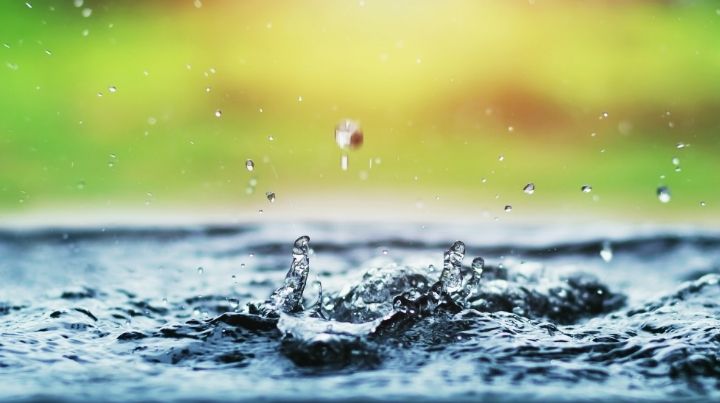77: Long-Term Water Storage for Emergencies


Podcast: Play in new window | Download
Long-term water storage isn't a glamorous topic. It's sure not as interesting as debates on gun calibers and freeze-dried foods. But long-term water storage should actually be one of your number one preparedness concerns.
Why Should You Think About Long-Term Water Storage?
Without clean drinking water, human life expectancy drops to around three days. Most of us in first-world nations take clean water for granted. However, circumstances may happen in which your household water faucets no longer deliver the precious life-sustaining liquid. When that happens, you'll need long-term water storage to tap into while you figure out your next steps.
While we purchase insurance for unexpected accidents or disasters, many don’t consider taking action to ensure our personal water supply. Fortunately, having a supply stashed away is insurance against unexpected water loss due to natural or human-made disasters.
Natural Disasters
Tornadoes, earthquakes, tsunamis, and other disasters can conceivably knock out a pumping station with a direct hit. Ironically, flooding due to strong storms can also cause shortages of potable water supplies if it contaminates local wells and municipal water supplies. Typically the impact of these events lasts only a few days and rarely directly disrupts the flow of water into your home. However, if your water continues to flow, you may be instructed to boil water to cleanse it of impurities for several days while they resolve the problem.
Earthquakes, perhaps the worst natural disruptor of water flow, potentially could destroy pumping stations, pipelines, and sewer lines. Under such circumstances, household plumbing could be rendered useless for a lengthy period of time. Events like that necessitate that people take long-term water storage more seriously.
Human-Made Disasters
Human-made disasters can include system failures caused by operator error, on-site accidents, an act of terrorism, war, or civil unrest. Recently, a plant operator at a Florida water facility discovered that someone had accessed the system and increased the amount of a dangerous chemical into the water supply. Fortunately, the hack was detected before there was any risk to residents, but it just goes to show how vulnerable our water supplies can be.
In yet another human-made disaster, a chemical spill rendered the water in West Virginia unusable for a couple of weeks, causing an instant shortage in bottled water being sold locally.
These are just two examples out of many. Depending on the severity of the damage done, these events could render you waterless for extended periods of time.
Health Impact of Drinking “Dirty” Water
Flooding is one of the most common reasons for water contamination, especially after natural disasters. Floods occur worldwide, and while most are a matter of inconvenience, the worst-case flood scenarios can bring life-threatening diseases to your water.
Some of the diseases that may accompany floods and disasters include typhoid fever, dengue fever, malaria, West Nile virus, cholera, yellow fever, leptospirosis, and hepatitis A. These do not always occur due to drinking the flood water but simply from being exposed to it. Learn more about the health hazards from floodwater here.
How Much Water Do You Use?
The classic rule of thumb is one gallon, per person, per day. But is that really accurate?
On average, most people drink less than a gallon of water per day. But it’s important to remember that we use water for more than drinking. Our extra water use needs to figure into our long-term water storage on a larger scale than many people currently do.
You will have to determine your daily water usage based on your personal needs, along with your speed and efficiency of getting tasks done. These estimates below are based on one person’s typical water use. If you have others to include in your preparedness planning, you’ll need to consider their usage as well.
- Drinking: 1 to 2 gallons (depending on the environment and amount of exertion)
- Bathing: 30 to 40 gallons (depending on tub size)
- Showering 30 minutes: 60 to 90 gallons (depending on the style of showerhead)
- Washing hands and face: 1 to 2 gallons
- Shaving: 1 to 2 gallons (legs or face)
- Flushing the toilet: 2 to 4 gallons (depending on the type and size of the toilet)
- Brushing teeth: 1 to 2 gallons
- Cooking: 1 to 3 gallons
- Washing dishes: 6 to 28 gallons (depending on your washing method)
- Washing clothes: 25 to 40 gallons (depending on how you wash clothes)
The total estimated daily usage for one person under normal conditions is 127 to 213 gallons. For a family of four, that comes out to 508 to 852 gallons.
If you cook three times a day, you could consume 3 to 9 gallons of water per day for total cooking. Flushing a toilet three times a day would likewise consume 5 to 12 gallons per day.
These aren't the only things to consider about how much water you need.
Other considerations that affect your total daily usage are:
- The number of family and friends living with you
- Pregnant and nursing women require more hydration and hygiene care
- Neighbors and others in need of help
- Using water as a currency or a bargaining tool
- Pets
- Livestock
- Gardens
Obviously, you can be more conservative with your water usage by limiting your showers and using the methods that use the least amount of water for your other tasks.
How Long Can Water be Stored Safely?
Water has no expiration. As per the FDA, clean water can be stored safely indefinitely unless exposed to contaminants. Municipal water pumped into your home arrives treated and is presumed to be clean and safe, although many debate that. However, after living for many years in the third world, I am confident that our water, while not pure, is drinkable in most circumstances.
Regardless of the condition of your public water supply, I recommend that you test your tap water before filling your storage containers. After all, why take a chance with one of your most critical preparedness needs. People who have tested their water occasionally find the presence of coliform bacteria (a.k.a. human feces contamination) despite treatment before arriving at their homes. Additionally, some tests may show a high level of rust in the water due to old pipes.
Home Water Filter
In addition to treating your water, I recommend using a home water filter, such as the Big Berkey. The Berkey Water Filter System is such a great water filter that I’ve used it for many years for all of my drinking and cooking water needs. Heck, even our dogs get Berkey filtered water.
Now, in full disclosure, I am a Berkey affiliate and do make a small percentage from any sales through my site. However, rest assured, I would never promote something that I don’t believe in, nor a product that I wouldn’t consider using in my own preparedness.
Long-Term Water Storage Containers
Despite many popular internet debates, many containers that are marketed for long-term water storage work great, as well as containers that are not marketed specifically for water.
The reality is that you do not need a blue drum or a certain type of container. The only true requirement is that the container is free of residual materials (if re-purposed) and free of bacteria, algae, or other contaminants. Heck, many people use two-liter soda bottles to get their budget-minded preparedness ball rolling. Check out this article on the CDC website for more information on using various containers for long-term water storage.
What are the best materials for long-term water storage containers?
High-Density Polyethylene (HDPE): HDPE containers are inert and impermeable. They are bisphenol A or BPA-Free. Because they are inert, they do not react with chemicals or other substances. Being impermeable means that chemicals or odors do not penetrate the container. In other words, you can store them without fear of nasty things leaching into your long-term water storage supply.
Glass Containers: Glass containers are also inert and impermeable, but there is the risk of breakage. Some argue these are not UV-resistant and promote bacterial and algae growth. The truth is, if you store clean water in clean containers, it should stay clean. The reality is that UV sunlight is an accepted method of inhibiting, not promoting, microbial growth in water. Both the Center for Disease Control and the World Health Organization are clear about the process of using UV light, which is called solar disinfection of SODIS.
Polyethylene Terephthalate (PET): PET is the recyclable plastic used to make the small-sized, portable water bottles that you find in stores. These typically hold 16.9 or 24 ounces of water. PET is approved by the FDA who states that it is safe for food and beverages. In fact, it is found in many packaging applications for foods and beverages. PET protects items like peanut butter, salad dressing, condiments, and 2-liter sodas.
Selecting the Right Size of Container
You probably have more options than you realize when selecting your long-term water storage containers. Food-grade plastic containers range from 16.9-ounce retail water bottles up to 20,000-gallon storage tanks. When it comes to containers, there are some basic issues that you’ll need to work through to maximize your long-term water storage preparedness.
Most homes have the ability to store water containers in a variety of areas. You can easily start by storing water in a cool part of a cellar, laundry room, attic, garage, or utility shed. Then as your supply grows, you can branch out to storing your water in multiple areas to allow for a more flexible system. If you don't have a cool area to store your water, make sure you rotate it out with fresh water on a regular basis.
Long-Term Water Storage in Small Spaces
If you live in an apartment or other small space, though, you may have to get creative with your storage. Look at storing cases or water bricks under your bed, under sinks, and in the unused spaces of closets. Some enterprising preppers have stacked cases to use as a table or shelf, covering it with an old tablecloth or bedsheet. Don’t forget to mark your containers with the date filled when storing them. Doing so will help you rotate your water efficiently and effectively.
- Small bottles in the case are stackable, easy to date and rotate, and portable.
- One gallon jugs are portable and easy to date/rotate, but not stackable (unless boxed).
- 3.5-gallon Water Bricks are portable, stackable, easy to date, and easy to rotate.
- Five-gallon bottles are portable, easy to date/rotate but are clumsy and not stackable unless you have a specialty rack.
- 7-gallon Aqua-Tainer jugs portable, easy to date/rotate but are not stackable.
- 55-gallon drums can be stacked if you’re equipped properly. They are also easy to date but are less portable and less easy to rotate.
Larger Long-Term Water Storage Containers
If you have room for larger containers, then you're in luck. Look for food-grade, UV-resistant water storage options. There are many options available on the internet. Make sure to do your due diligence when buying water containers so that your water is as prepared as you are.
Determining the correct amount of water to store and selecting appropriate containers requires you to examine your current usage and use that to estimate your usage during an emergency.
Taking the time to plan, prepare, and make the proper call about your long-term water storage now, can save you when disaster strikes.
The Bottom Line on Long-Term Water Storage
When creating your long-term water storage plan, there are many details such as where to store it, how to store it, what's actually in it, and how much you need. It makes me think of a quote by Erin Brockovich, who said,
“Awareness is key. In the absence of information, none of us know what is happening and what could be jeopardizing our health, our water supply, and our planet.” ~Erin Brockovich.
I say be aware and get informed.
How do you store your water for the long term? How did you calculate the amount you needed? Do you have any questions about long term water storage? Share your best tips and ask your questions in the comments.
Stay safe,

Related Articles
FREE Guide
Read the Best Seller
Join Mind4Survival
Stay informed by joining the Mind4Survival! 100% Secure! 0% Spam!
Affiliate Disclosure...
Mind4Survival is a free, reader supported information resource. If you make a purchase through our link, we may, at no cost to your, receive an affiliate commission.
Do You Want To Be Ready No Matter What?

Download our free 39-page guide with interactive, 7-Day Emergency Kit Checklist and take the first step toward real preparedness.
- Know exactly where to start.
- Save time and money.
- How-to build a complete Basic Emergency Kit.
- Level up your safety and security.
Join Mind4Survival
Stay informed by joining the Mind4Survival! 100% Secure! 0% Spam!






Let’s be a bit more realistic.
You’re not going to be taking baths. You’ll be showering for two minutes every few days if you can. Not 30 minutes. A quick wash of face and hands might use a pint.
The dish cleaning thing is pretty accurate, but your clothes washing is way high. We don’t use that much for two loads, much less one.
Toilets have been less than two gallons a flush for about thirty years.
Now we can start calculating.
Purchasing laundry soap in largest container possible, when empty I rinse, fill with water a dash of bleach then store outside in the shade. I’ve already paid for the container so why not use? This will be the water used in our porta potty. can’t waste fresh water.
GreatGrandMom
That’s a great money savings hack! Thanks for sharing! ~Brian
I have been buying one-gallon plastic bottles of both distilled and spring water for about a year. Use these for all drinking-water daily and rotate by date purchased. So far, have just stored these in my pantry.
Have read that thin plastic used for these bottles breaks down slowly and releases plastic particulate into the water. You’re saying we can store these in a hot garage, but these can climb to and stay in the 90’s through every summer day here (Texas).
Anyone have thoughts about this issue? Thanks!
Very good point! The post is updated to account for hot TX garages. If water is stored in hot areas, the water will need to be rotated on a more frequent basis.
I wouldn’t trust the CDC or WHO with anything. They have an agenda that doesn’t match mine. I save my used dish water to flush the toilet, water house plants. And I do believe in “if its yellow, let it mellow. If its brown flush it down “(with used dish water). You are not thinking desperate enough. NO long showers, No dishwasher, only do laundry when you have a full load. Dont let the water run when you brush teeth. Same for shaving. Use a small container and rinse the blade now & then. Way too much waste!! This is SHTF time.